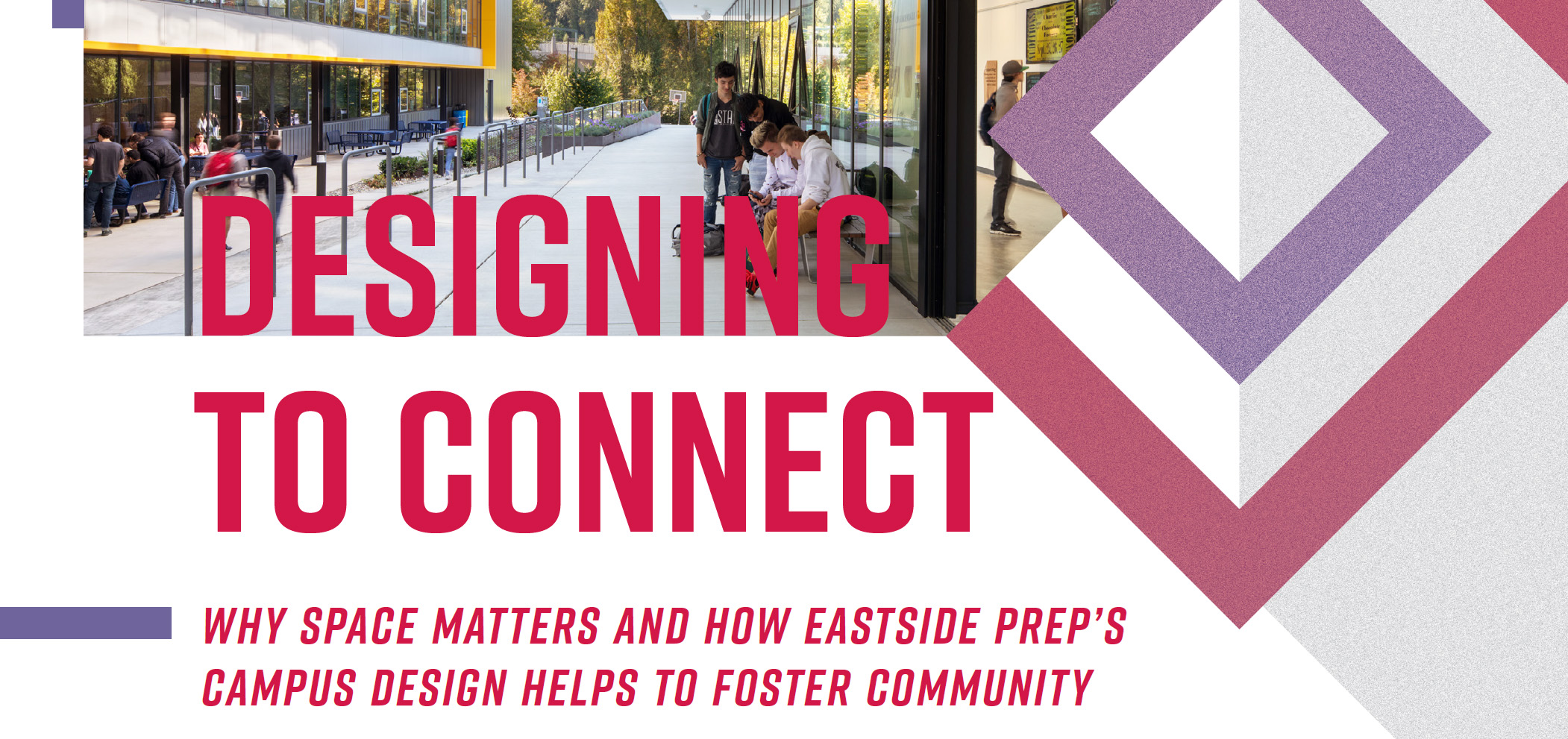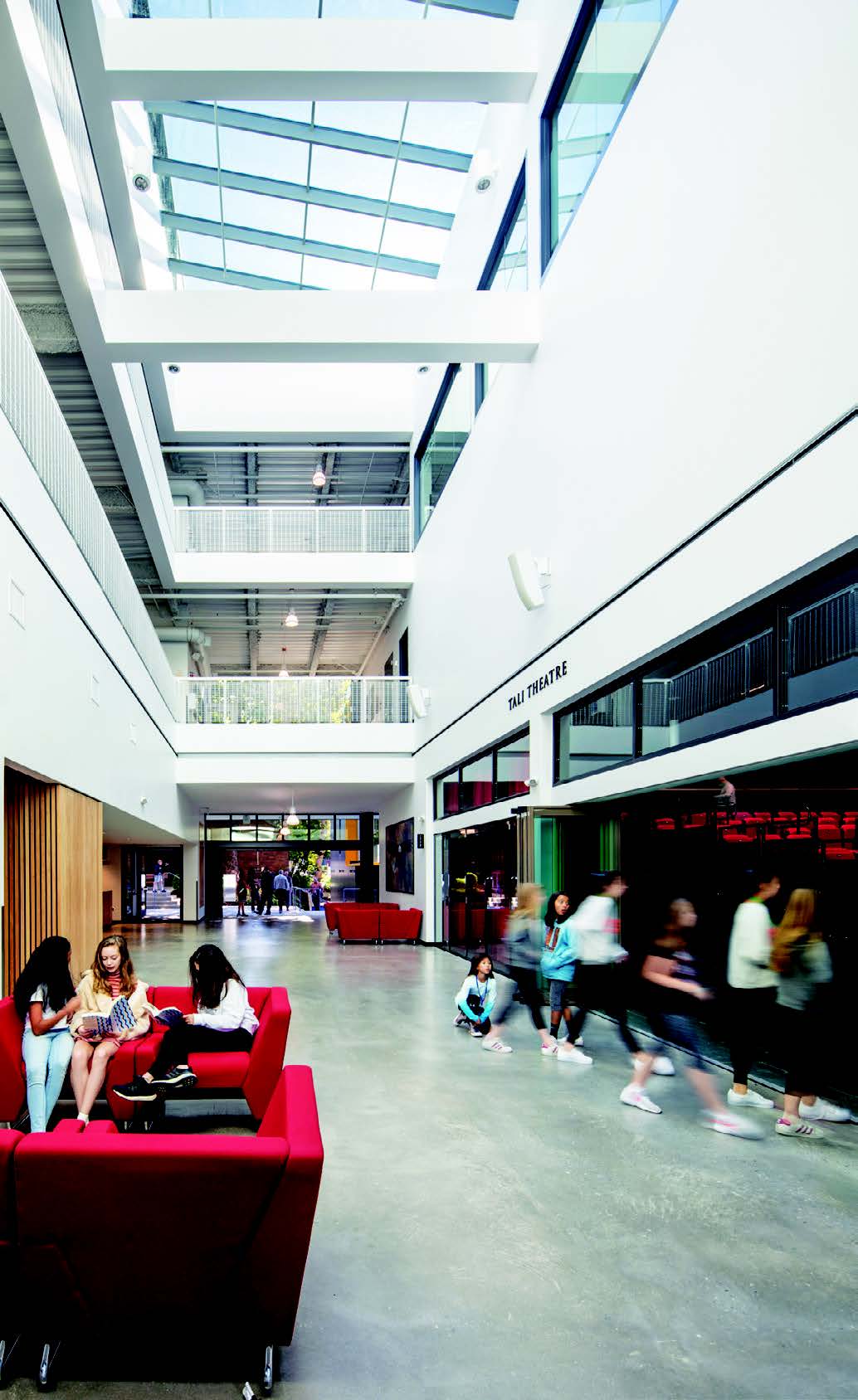
By Cheryl Miller, Director of Enrollment Management
THE FIRST TIME THAT FOLKS VISIT THE EPS campus, many of them comment on how our school does not look like a school. A modern workplace? Yes. A place for innovation? Yes. A school? No. The evolving EPS campus, set within the Linbrook Office Park, did not begin its structural life as a set of school buildings. Yet through a series of renovations and new building projects the campus has grown, and we have very intentionally continued our departure from the common spatial template of schools. The EPS campus eschews traditional school campus designs in several ways.
First, the campus is building up instead of out. Utilizing the footprint of pre-existing structures in the office park, half of Eastside Prep’s main campus buildings exceed the typical one-to-two story height of most school structures. Our four-story structures, TALI Hall and The Macaluso Academic Collaborative (TMAC), provide us with a vertical—rather than a horizontal—campus orientation. In addition to the cardiovascular benefit of ascending the stairs in these buildings, the key benefit is that of proximity. “The campus is a decidedly urban solution that preserves open space and invites community closeness,” says Bob Baldwin, who has served the EPS community as the project manager for our building projects. “With more folks under one roof, the opportunities for interaction grow exponentially, naturally discouraging the cliques and silos that can be part of organizations like schools.” Particularly in a program that spans eight grade levels, it is invaluable to have this contact time between those who may not typically interact within classes and co-curricular activities. In addition to the benefit proximity brings to the human community, our tall buildings have a more positive environmental impact. Baldwin notes, “By building up and not out, we reduce the carbon footprint of the campus, with fewer roofs and impervious surfaces.”
DESIGNING FOR WELL-BEING
EPS fosters student well-being through direct education and programming, wellness resources, and the cultivation of genuine human connections. Among our efforts to improve and enlarge our built spaces over time have been those that directly enhance student well-being:
2017
- LPC Remodel
2018
- Friel Learning Center (TALI Hall)
- Two school counselor offices for individual and group meetings
- Guided Study Hall meeting spaces
- Quiet work and testing spaces
- Yoga space renovated (LPC)
- Equity, Inclusion, and Compassionate Leadership Office added (LPC)
- Parent education space (Annex)
- Cognitive Restoration Studio (TALI Hall)
2019
- School Nurse Office (LPC)

Another distinguishing factor of the EPS campus design is the openness of these spaces. In the renovation of the Levinger-Poole Commons (LPC), as well as in TMAC and TALI, natural light is a primary building material. Jeff Boone of Public 47 Architects LLC designed these spaces to harness this natural resource. “We worked hard to create lots of transparency using floor-to-ceiling glass, including large folding glass doors in TALI. These create a generous connection between the new pedestrian plaza, the atrium, and the TALI Theatre,” says Boone. In addition to the new TALI entry and atrium, the roll-up windows in the LPC open to the pedestrian plaza and further expand the feeling of openness on the campus—just one of the many benefits that came with the LPC renovation. “Before the remodel, the second floor was disconnected from the main dining hall space. The remodel visually opened up the second-floor classrooms and offices to the main dining hall space. Not only did this create a better connection between the classrooms and offices, it also improved supervision between the spaces.” Now there are informal meeting spaces outside the upper classrooms, offices overlooking the main dining space, and private dining spaces for lunch time meetings. Boone adds, “With the addition of TALI Hall, the Commons has become a more dynamic link at the heart to the campus between the Middle School, TMAC, and TALI.” Another aspect of our open design is that many internal walls and doors feature large panes of glass, thus providing vantage into spaces even when the doors are closed for acoustic reasons. This openness provides both literal and figurative transparency as classes, groups, and individuals meet together. The effect of seeing groups interact throughout the campus has a positive impact on school culture—sending a message that conversations and activities should be transparent, even when they are not directly participated in. Beyond the large windows and glass doors, the operable ‘sky’ wall can be opened to connect the balcony in TALI to the main theatre. This dynamic ability in the space allows us many new opportunities to gather as a whole school community, from arts events to assemblies, while retaining use of the spaces for different purposes concurrently.
Mutual ownership is another way in which the use of space reinforces our culture. “The desire to encourage collaboration drove the design for spaces and furniture,” says Baldwin. Configurations of tables, soft seating areas, and media-enhanced meeting spaces all help students and faculty work together. Additionally, very few members of the faculty use just one classroom space for teaching. Rather, most teachers will hold classes, advisory groups, and activities in more than one space on the campus. Faculty offices/desks are most often separate from the classrooms in which they teach, and the majority are grouped together in communal spaces. As a result, a shared stewardship of space reinforces the mutual ownership of the campus by students and faculty alike.
Community offices and the LPC dining areas lend themselves to conversation, and have often resulted in new collaborations among faculty teaching in different disciplines. “This past year, I was lucky enough to share an office with four wonderful educators, all of whom have been incredibly helpful and supportive during my first year at EPS,” shares Whitney Stange, Fine & Performing Arts faculty. “The first day in our office that I met Ian Duncan, an English teacher, I could feel his passion for Shakespeare and theatre. After getting to know him and understanding his talents, I asked him if he would be willing to lend his expertise to our production of A Midsummer Night’s Dream. Thankfully he agreed and the result was a fantastic partnership and a cast that performed a play of the highest quality.” Stange adds regarding another collaboration:
I also had the great fortune this year to team up with our amazing music teacher, Ginger Ellingson, our talented art teacher, Amis Balcomb, and our charismatic PE teacher, Melissa Hayes. Through discussion in the LPC at lunch, we discovered that we all had the same period in the spring trimester with Middle School students and enrollment in each class that was manageable enough for us to collaborate on a larger group project. With administrative support we combined our classes and created a modern-day musical version of Peter Pan. Students engaged in a truly one-of-a-kind experience where they were able to adapt a script, add music, choreograph, and design a set, costumes, and props based on the point of view that they collectively shared. The result was a student-driven performance that they owned, and of which they were very proud.
Melissa Hayes added, “Seeing and interacting with students and colleagues in such varied spaces and contexts means that every day is new and interesting—it elevates our experiences.”
The design of our campus nurtures the fundamental element of an EPS education: connection. Our community is formed through close relationships, openness, and collaboration, qualities facilitated through our spaces’ vertical orientation, transparency, and mutual ownership. As we continue to design and refine our core program for the well-being of our students, our campus design in turn reflects the value of connection.

